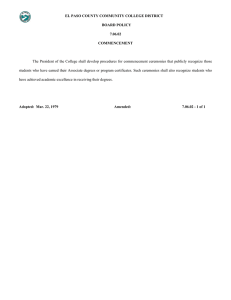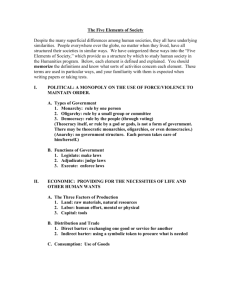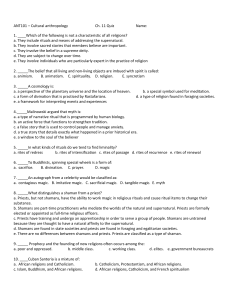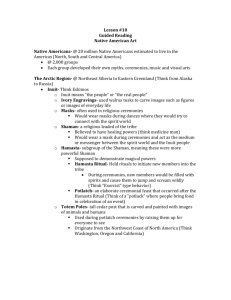Spirituality, Religion, and the Supernatural Part II
advertisement
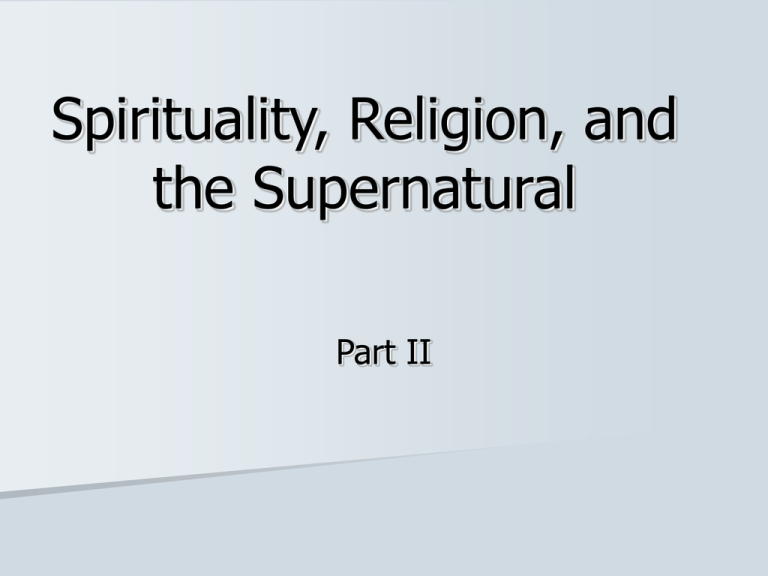
Spirituality, Religion, and the Supernatural Part II Animism: A belief that natural objects are inhabited by spirits OR All things in nature may be thought of as having the same spirit. In both forms of animism, the spirits are thought of as having – Identifiable personalities and other characteristics such as gender. – A belief in a powerful, mature, or protective, personality. – The spirits may be benevolent, malevolent, or neutral Animatism: It is a belief in a non physical essence or force or power or whatever you want to call i – the power is usually impersonal, unseen, and potentially everywhere. It is neither good nor evil, but it is powerful and dangerous if misused. Among the Polynesian cultures of the Southern Pacific Ocean, this power is called "mana – Some things or people have more of it than others and can be potentially dangerous. Animism vs. Animatism: Both: – Beliefs are often found in the same culture. – Can have the two beliefs combined in one object A tree may have an individual spirit and also hold an impersonal force Difference: – Animatism does not have a personality--it is an impersonal "it" rather than a "he" or "she". – Animism can have gender and/or personality characteristics similar to people Religious Specialists: All human societies include individuals who guide and supplement the religious practices of others. – Such individuals are seen to be highly skilled at contacting and influencing supernatural beings and manipulating supernatural forces. They may have undergone special training and may display certain distinctive personality traits that make them particularly well suited to perform these tasks. Priests and Priestesses: Priest or priestess: a full-time religious specialist formally recognized for his or her role in guiding the religious practices of others and for contacting and influencing supernatural powers – He or she is the socially initiated, ceremonially inducted member of a religious organization. Priests and Priestesses: With their god defined historically in masculine, authoritarian terms, it is not surprising that, in the Judaic, Christian, and Islamic religions, the most important positions traditionally have been filed by men. Female religious specialists are likely to be found only in societies where women are acknowledged to contribute in a major way to the economy and where gods and goddesses are both recognized. Shamans: Societies that lack full-time occupational specialization always included individuals with special powers and skills that enable them to connect with and manipulate supernatural beings and forces. – These powers have come to them through some personal experience, usually in solitude. – Shamans: Shaman: a person who enters an altered state of consciousness, at will, to contact and utilize an ordinary hidden reality in order to acquire knowledge, power, and to help others. – The shaman has at least one, and usually more, ‘spirits’ in his or her personal service The word shaman originally referred to medicalreligious specialists, or spiritual guides, among the Tungus and other Siberian pastoral nomads with animist beliefs. Shamans: Typically, one becomes a shaman by passing through stages of learning and practical experience, often involving psychological and emotional ordeals brought about by isolation, fasting, physical torture, sensory deprivation, and/or hallucinations. By means of various techniques such as fasting, drumming, chanting, or dancing, as well as hallucinogenic mushrooms, shaman enter into a trance, or altered state of consciousness. Shamans: The widespread occurrence of shamanism and the remarkable similarities among shamanic traditions everywhere are consequences of a universal neurological inheritance. At the same time, the meanings ascribed to sensations experienced in altered states and made of their content are culturally determined; hence, despite their overall similarities, local traditions always vary in their details. Shamans: The shaman is essentially a religious gobetween who acts on behalf of some human client, often to bring about healing or to foretell some future event. – In return for services rendered, the shaman may collect a fee; fresh meat, yams, or a favorite possession. – In some cases, the added prestige, authority, and social power attached to the shaman’s status are reward enough. Shamans: In many human societies, sleight-of-hand tricks and ventriloquism occur at the same time as trancing. – Some Western observers regard this kind of trickery as evidence of the fraudulent nature of shamanism. – The shaman regards his or her ability to perform extraordinary tricks as further proof of superior powers. The Shamanic Complex: From an anthropological perspective, shamanic healings can be understood by means of a three-cornered model we call the shamanic complex or ‘magic field’. This triangle is created by the relationships among the shaman and the patient and the community to which both belong. Rituals and Ceremonies: Religious ritual is the means through which people relate to the supernatural; it is religion in action. Ritual serves to relieve social tensions and reinforce a group’s collective bonds. – More than this, it provides a means of marking many important events and lessening the social disruption and individual suffering of crises, such as death. Rites of Passage: Rites of passage: a ritual that marks an important stage in an individual’s life cycle, such as birth, marriage, and death. – Rites of passage help individuals through the crucial crises or major social transitions in their lives, such as birth, puberty, marriage, parenthood, advancement to a higher class, occupational specialization, and death. Rites of Passage: Arnold van Gennep divides ceremonies for all life crises into three stages: – Separation: in a rite of passage, the ritual removal of the individual from society – Transition: in a rite of passage, isolation of the individual following the separation and prior to incorporation into society. – Incorporation: in a rite of passage, reincorporation of the individual into society in his or her new status. Rites of Passage: Aborigines of Australia: – When the elders decide the time for initiation, the boys are taken from the village (separation), while the women cry and make a ritual show of resistance. – In the transitional stage, the novice may be shown secret ceremonies and receive some instruction, but the most significant element is his complete removal from society – On his return to society (incorporation), the novice is welcomed with ceremonies, as though he had returned from the dead. Rites of Passage: Mende girls in West Africa: – After they have begun to menstruate, the girls are removed from society to spend weeks, or even months, in seclusion (separation). – Shortly after entering this transitional stage, the girls undergo clitoridectomy, a form of female circumcision that they and Mende in general believe enhances their reproductive potential. – Mende women emerge from their initiation (incorporation), then, as women in knowledgeable control of their sexuality, eligible for marriage and childbearing Cultural Relativism: Anthropological commitment to cultural relativism permits an understanding of the practice of clitoridectomy in the Mende female initiation rites. Cultural relativism does not preclude the anthropologist from criticizing a given practice. Not surprisingly, female circumcision; commonly referred to as female genital mutilation (FGM) and practiced in various forms in Asia and Africa especially; has been much condemned as a human rights violation in recent years. Rites of Intensification: Rites of intensification: a ritual that takes place during a crisis in the life of the group and serves to bind individuals together. – This unites people in a common effort so that fear and confusion yield to collective action and a degree of optimism. – The balance of the relations of all concerned is restored to normal and the community’s values are celebrated and affirmed Rites of Intensification: Funerary ceremonies can be regarded as rites of intensification that permit the living to express in non-disruptive ways their upset over the death while providing for social readjustment. According to Malinowski, funeral ceremonies provide an approved collective means for individuals to express these feelings while maintaining social cohesiveness and preventing disruption of society. Rites of Intensification: The performance of rites of intensification does not have to be limited to times of overt crisis. In regions where the seasons differ enough that human activities must change accordingly, they will take the form of annual ceremonies. – These are particularly common among horticultural and agricultural people, with their planting and harvest ceremonies. Question The anthropologist Arnold Van Gennep analyzed ceremonies that help individuals through crucial stages of their life cycles. He said that each ceremony may be analytically divided into three stages, _____________, transition, and incorporation. A. B. C. D. E. inculcation separation revitalization intensification initiation Answer: B The anthropologist Arnold Van Gennep analyzed ceremonies that help individuals through crucial stages of their life cycles. He said that each ceremony may be analytically divided into three stages, separation, transition, and incorporation. Question The major difference between animism and animatism has to do with whether the supernatural force which occupies an entity is _______________. A. personal or impersonal (a being or an impersonal force without identity) B. natural or supernatural C. a god or an ancestral spirit D. a priest or a shaman E. an example of witchcraft or of divination Answer: A The major difference between animism and animatism has to do with whether the supernatural force which occupies an entity is personal or impersonal (a being or an impersonal force without identity). Question Ceremonies such as bar mitzvahs, elaborate wedding ceremonies, baby showers, and graduation parties that help individuals make major changes in their lives are referred to as rites of _______________. A. B. C. D. E. Transition Intensification Separation Passage Incorporation Answer: D Ceremonies such as bar mitzvahs, elaborate wedding ceremonies, baby showers, and graduation parties that help individuals make major changes in their lives are referred to as rites of passage. Question The anthropologist Arnold Van Gennep analyzed ceremonies that help individuals through crucial stages of their life cycles. He said that each ceremony may be analytically divided into three stages, _______________, transition, and incorporation. A. B. C. D. E. Inculcation Separation Revitalization Intensification Initiation Answer: B The anthropologist Arnold Van Gennep analyzed ceremonies that help individuals through crucial stages of their life cycles. He said that each ceremony may be analytically divided into three stages, separation, transition, and incorporation. Question Cultural relativism does not preclude the anthropologist from criticizing a given practice. A. True B. False Answer: A Cultural relativism does not preclude the anthropologist from criticizing a given practice. TRUE
